Many homeowners struggle with how to hide wires under cabinet lighting, as they can clutter the space and diminish the overall aesthetic appeal of the kitchen. Fortunately, with a little know-how and some helpful tips, you can easily achieve the clean and organized look you desire. In this guide, I will walk you through the process of under cabinet wire concealment and share some tricks for hiding electrical cords in a way that enhances your kitchen design.
Key Takeaways
- Under cabinet lighting serves both functional and aesthetic purposes in your kitchen.
- Planning ahead and considering the type of lighting you’ll use is crucial for successful wire concealment.
- DIY solutions like creating a custom T-Square drill guide can be helpful when hiding wires.
- There are different lighting styles to choose from, such as strip lights and puck lights.
- Methods for camouflaging wires include using valances, recessed bottoms, and coverboards.
- Countertop finishes can impact the appearance and effectiveness of under cabinet lighting.
- Ensure proper electrical safety when installing under cabinet lighting systems.
Understanding Under Cabinet Lighting Benefits
Under cabinet lighting isn’t just for aesthetics – it’s about functionality, too. It provides task lighting, which is essential for performing kitchen chores, especially for those with poor eyesight. This targeted illumination not only makes tasks easier but can enhance the overall efficiency of your kitchen workspace. Let’s delve deeper into the functional aspect and design aesthetics of under cabinet lighting.
Task Lighting: The Functional Aspect
Task lighting is crucial for a well-functioning kitchen, as it helps with activities like food preparation, cooking, and cleaning. The precise illumination it renders maintains high visibility, enhances safety, and reduces eye strain. With proper task lighting, you can retain a comfortable, ergonomic, and productive workspace.
Under cabinet lighting is an excellent source of task lighting for countertops and workspace areas.
Some tasks that benefit from under cabinet lighting include:
- Chopping vegetables or fruits
- Measuring and mixing ingredients
- Reading recipes or labels
- Searching for items in drawers or cabinets
Design and Aesthetics: Complement Your Kitchen Style
Beyond its practical benefits, under cabinet lighting contributes to your kitchen’s style, whether it’s traditional or modern. The right lighting can enhance your kitchen’s aesthetic appeal, complementing the designs and creating an inviting atmosphere for both cooking and socializing.
When it comes to kitchen design, under cabinet lighting can unify the look of your space. Whether you want a sleek, modern appearance or a cozy, traditional feel, the right lighting can bring your vision to life. Let’s explore how under cabinet lighting impacts various kitchen styles:
| Kitchen Style | Lighting Impact |
|---|---|
| Minimalist | Hidden lighting creates a clean, uncluttered look with seamless integration. |
| Contemporary | LED strip lights under cabinets provide sleek illumination and blend well with modern finishes. |
| Traditional | Puck lights or light bars offer a classic touch and enhance features like crown molding. |
When designing your kitchen, understanding the benefits of under cabinet lighting can help you make the best choices for your space. From task lighting and overall functionality to aesthetics and ambiance, under cabinet lighting is an essential component of any successful, stylish, and efficient kitchen design.
Initial Considerations for Wire Hiding Projects

When considering how to hide wires for under cabinet lighting, it’s important to weigh the aesthetics and functionality. Think about the type of lighting you’ll use, how the wires can be concealed, and the impact on your kitchen’s design. Planning ahead can make a big difference in the quality of your project. In this section, we will cover essential aspects that need to be considered while planning a wire hiding project for under cabinet lighting.
- Lighting Type: Understand the type of under cabinet lighting you’re planning to use, whether it’s strip lights or puck lights.
- Wire Hiding Techniques: Identify the best method for concealing wires in your kitchen: valance, recessed bottoms, or coverboards.
- Organizing Wires: Ensure a well-functioning under cabinet lighting system by organizing wires efficiently.
- Compatibility with Kitchen Design: Select wire hiding techniques that complement your kitchen’s existing style.
Here are some factors to take into account when selecting the perfect wire hiding technique for your kitchen:
| Factors | Valance | Recessed Bottoms | Coverboards |
|---|---|---|---|
| Aesthetics | Adds decorative detail | Offers a clean, minimalist look | Provides a finished appearance |
| Functionality | Effectively conceals lighting and wires | Tucks lighting and wires neatly away | Camouflages wires while allowing easy access |
| Installation | Simple attachment or stand-alone piece | Requires a cabinet with a recessed bottom | Can be installed onto existing cabinetry |
| Cost | Varies depending on materials and complexity | May require additional carpentry work | Subject to material cost and customization |
By taking the time to examine these factors and determine the best approach for organizing wires for under cabinet lighting, you’ll create a more polished and functional kitchen space that reflects your personal style and preferences. In the end, effective under cabinet lighting wire management will make your kitchen much more enjoyable to use and elevate its overall appearance.
DIY Drill Guide: Creating a Custom T-Square
To hide wiring effectively, a custom T-Square drill guide can be really handy, especially for running wires discreetly. With some scrap wood and a few tools, you can create your own guide and save money in the process. In this section, I will discuss the materials needed and provide step-by-step instructions for building your own DIY T-Square drill guide.
Materials Needed for Your T-Square Drill Guide
To make your own homemade T-Square drill guide, gather the following materials:
- 1x plywood board (12″ x 12″ minimum size)
- Wooden dowel or metal pipe (1/2″ diameter)
- Forstner bit (1/2″)
- Wood screws
- Power drill
- Wood glue (optional)
- Sanding paper
- Measuring tape or ruler
- Pencil
Note: Ensure that the plywood board is at least 3/4″ thick to accommodate the hole for the dowel or pipe.
Step-by-Step Instructions to Build Your Drill Guide
Follow these custom T-Square instructions to create your DIY drill guide:
- Mark the center of the plywood board. Use the measuring tape or ruler and pencil to find and mark the center of the plywood board.
- Drill a guide hole through the center of the board. Attach the Forstner bit to the power drill and carefully drill a hole through the center of the plywood.
- Create a waste relief on the backside of the plywood. To allow for easy wire routing, use the Forstner bit to create a shallow recess on the backside of the plywood, directly opposite of the hole drilled in step 2.
- Insert the dowel or pipe into the guide hole. Apply a small amount of wood glue inside the hole (optional) and insert the dowel or pipe into the hole. If using a pipe, ensure it has a flanged end to prevent it from slipping through the hole.
- Secure the dowel or pipe in place with screws. To prevent the dowel or pipe from moving, attach it to the plywood board with wood screws, ensuring they are evenly spaced.
- Sand and clean the T-Square drill guide. Remove any rough edges on the plywood using sanding paper. Clean up any wood shavings and glue residue.
With this homemade T-square drill guide, you’ll have a convenient DIY wiring solution to help you route wires within your under cabinet lighting project while keeping your cabinets unblemished. Plus, the satisfaction of knowing you made it yourself!
Types of Under Cabinet Lighting: Strip vs. Puck Lights
When planning your under cabinet lighting project, one of the essential decisions you’ll make is whether to choose under cabinet strip lighting or puck lights. Both lighting styles have their unique attributes that can affect the overall look and functionality of your kitchen space, as well as the way wires are hidden. In this section, we’ll delve into the differences between these popular lighting options to help you make an informed decision.
Choices in lighting—strip lights or puck lights—can affect how you hide wires. Strip lights are ideal for even lighting distribution, while puck lights create focal lighting. Depending on which you choose, you’ll need to adapt your wire hiding methods accordingly.
Let’s break down the specifics of each type:
- Under Cabinet Strip Lighting: These lights are thin and flexible, making them ideal for attaching to the underside of cabinets. Strip lights provide an even distribution of illumination, covering the entire countertop with minimal shadowing. Wires can be concealed more easily due to the thin and flexible nature of strip lights, making them a popular choice for those who prioritize a seamless, tidy appearance.
- Puck Lights: Puck lights are round, compact fixtures that provide more focused lighting. They are ideal for accentuating specific areas of your countertop or highlighting unique features, such as a backsplash. Due to their distinct shape, puck lights may require more deliberate wire-hiding approaches, such as drilling holes in the cabinets or utilizing coverboards.
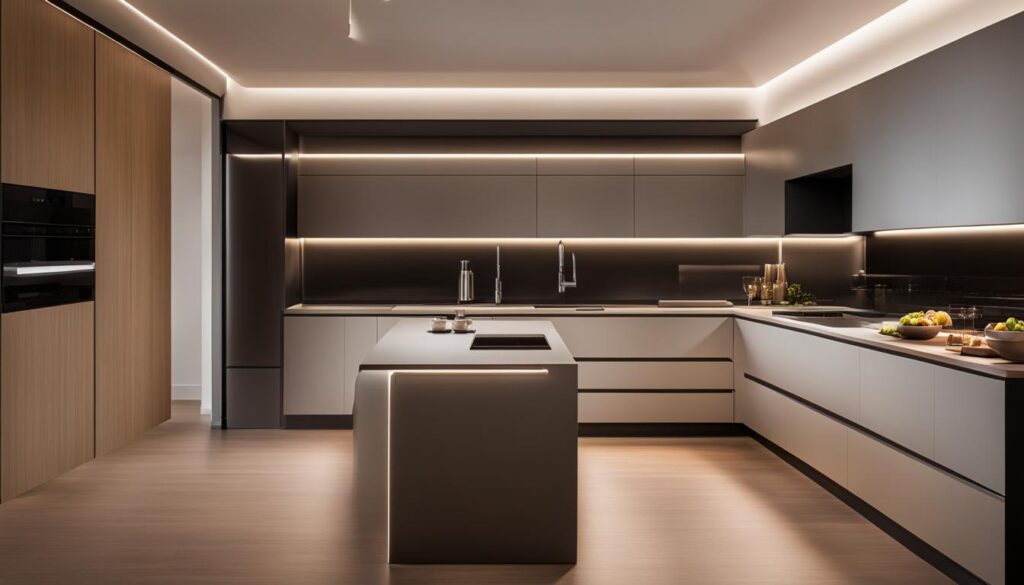
When comparing strip lights and puck lights, consider not only the aesthetic you want to achieve but also the wire management requirements. Depending on your choice, different techniques will be needed to ensure a clean and organized appearance. Ultimately, both under cabinet strip lighting and puck lights can significantly enhance the look and functionality of your kitchen, so weigh the pros and cons of each option before committing to one or the other.
| Lighting Type | Appearance | Illumination | Wire Management |
|---|---|---|---|
| Strip Lights | Thin and flexible | Even lighting distribution | Easier to conceal |
| Puck Lights | Round and compact | Focal lighting | May require strategic hiding techniques |
Now that you’re familiar with the different attributes and wire management implications of under cabinet strip lighting and puck lights, you’re better prepared to finalize your lighting design and embark on your wire-hiding venture. With careful planning and informed decisions, you can achieve a well-lit and organized kitchen without any unsightly wires in sight.
Techniques for Camouflaging Wires: Valance, Recessed Bottoms, and Coverboards
Camouflaging wires effectively can greatly enhance the aesthetic appeal of your kitchen. In this section, I will discuss three main methods for hiding under cabinet lighting wires – valance, recessed bottoms, and coverboards. These methods not only conceal the wires but also elevate your kitchen’s overall design.
- Valance: Valances are decorative molding pieces installed below the cabinets, covering the lighting and adding an extra layer of aesthetic detail. These additions serve a dual purpose – they provide attractive accents to your cabinets and effectively conceal any exposed wiring.
- Recessed Bottoms: Recessed bottoms refer to under cabinet sections that protrude slightly from the edge of the cabinet bottom, forming a small space where the lighting and wires can be neatly tucked away. This method is particularly effective for minimalist kitchen designs, as it keeps wires completely out of sight.
- Coverboards: Coverboards are thin strips of material (wood or plastic) that can be attached to the underside of your cabinets, providing a neat channel for the wires to run through. These coverings hide the electrical components from view, giving your under cabinet lighting a clean and seamless appearance.
Choosing the best technique largely depends on your kitchen’s design and personal preferences. Here’s a quick comparison of the three methods:
| Technique | Aesthetic Appeal | Effectiveness in Hiding Wires | Suitability for Various Kitchen Styles |
|---|---|---|---|
| Valance | High | Moderate to High | Best for traditional kitchens |
| Recessed Bottoms | Minimalist | High | Best for modern kitchens |
| Coverboards | Flexible | Moderate to High | Suitable for various styles |
Remember that the key to successful cable management lies in careful planning and the right approach. Whichever camouflaging technique you choose, it’s essential to ensure the method fits your kitchen’s aesthetic and fulfills your functional requirements.
Pro tip: To further enhance your under cabinet lighting wire management, consider combining these techniques or using complementary cable management ideas, such as adhesive cable clips or cable ties for organizing wires.
Matching Under Cabinet Lighting with Countertop Finishes
When it comes to enhancing your kitchen design, the type of countertop finish plays a role in the effectiveness of your under cabinet lighting. A crucial aspect to consider is the amount of light reflection you want in your kitchen space. The two most popular finish options, polished countertops and honed countertops, offer different reflective properties and have specific implications for your lighting choices.
Polished vs. Honed Countertops: Reflective Considerations
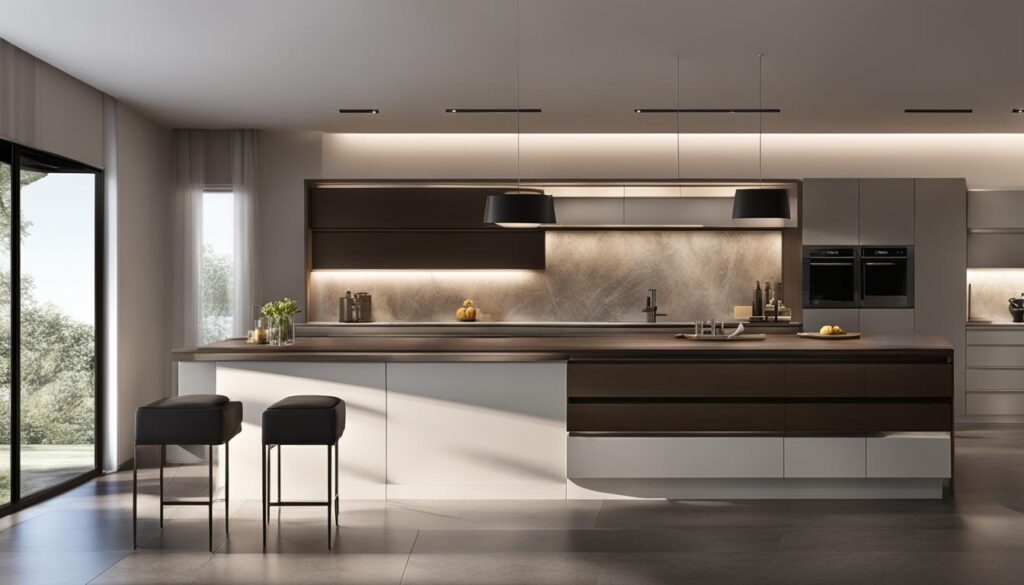
Polished countertops provide a sleek, glossy surface, reflecting light more than their honed counterparts. This higher degree of reflection can sometimes result in glare if not combined with the appropriate under cabinet lighting. On the other hand, honed countertops have a matte finish, offering a more muted appearance that handles light reflection more subtly.
Polished countertops have a sleek, glossy surface, while honed countertops have a matte finish, creating different reflective effects.
Understanding how countertop finishes affect under cabinet lighting reflection is essential for making the right decision. Below is a comparison of the two finishes and their compatibility with under cabinet lighting:
| Finish Type | Reflection Properties | Advantages | Considerations for Under Cabinet Lighting |
|---|---|---|---|
| Polished Countertops | High-level of light reflection | Luxurious shine and appearance | May cause glare if not properly combined with under cabinet lighting |
| Honed Countertops | Subtle light reflection | Modern, sophisticated look | Low risk of glare but may require additional sources of light |
As you consider the countertop finishes in your kitchen design, ensure you match the reflective properties with the most suitable under cabinet lighting options. This will contribute to a harmonious and aesthetically pleasing kitchen space catered specifically to your lighting preferences.
Adding Under Cabinet Lighting to Existing Kitchens: Is it Possible?
Retrofitting under cabinet lighting is a popular existing kitchen upgrade, providing additional lighting and ambiance even after the initial construction. Though it might seem challenging to add under cabinet lighting to a finished kitchen, there are a few accessible options.
One solution is using battery-powered puck lights, a user-friendly choice that requires no electrical wiring. These puck lights can be effortlessly mounted underneath your cabinets, providing convenient and functional lighting without the need for complex installations. It’s a quick and easy option for those looking to enhance their kitchen’s atmosphere without going through a major renovation.
For more extensive upgrades that include hard-wired installations, some electrical work may be needed. Integrating under cabinet lighting into your existing kitchen design without disturbing the cabinetry or aesthetic can prove challenging, but with careful planning and execution, it is a viable option.
Consulting with a professional electrician can be essential in determining the best route to take when retrofitting under cabinet lighting, ensuring both safety and seamless integration.
Companies like Philips Hue and Lutron offer excellent solutions suitable for integrating under cabinet lighting into existing kitchens, allowing you to effectively conceal wires and achieve a polished look. Here are some products suitable for retrofitting under cabinet lighting:
- LED light strips with adhesive backings
- Plug-in puck lights
- Low-profile modular lighting units
When considering adding under cabinet lighting to your kitchen, it is crucial to think about your available space, electrical infrastructure, and desired end result. With adequate research and planning, retrofitting under cabinet lighting can increase the value, functionality, and aesthetic appeal of your existing kitchen.
Cost Breakdown: Lighting, Labor, and Hidden Costs
When it comes to installing under cabinet lighting in your home, it’s crucial to have a clear understanding of the expenses involved. The cost of under cabinet lighting varies greatly based on factors such as the quality, type of lighting chosen, and installation expenses. In this section, we will explore the costs associated with the materials and professional installation of under cabinet lighting.
Breaking Down the Material Costs
The cost of under cabinet lighting largely depends on the style and quality of the lights you select. For example, affordable options can cost around $20 per light, while premium choices may exceed $160 per light. It’s essential to research and compare products to find the best combination of quality, design, and value.
By researching different under cabinet lighting options, you can find the best fit for your style and budget.
Understanding the Expense for Professional Installation
While some individuals may feel comfortable installing their under cabinet lighting, hiring a professional electrician is highly recommended to ensure electrical safety and adherence to code standards. Electrician labor costs can vary between $70 – $120 per hour, which may vary based on your location, job complexity, and the service provider’s experience.
| Expense | Average Cost |
|---|---|
| Material costs (per light) | $20 – $160 |
| Electrician labor costs (per hour) | $70 – $120 |
It is important to note that there may be additional costs during the installation process, such as permits, additional wiring, or repairs. You should always request a detailed quote from your electrician before hiring them to get an accurate understanding of all expenses involved in your under cabinet lighting project. Keep in mind that the higher cost for professional installation is often worth the added level of expertise, safety, and long-term functionality that comes from working with an electrician.
Investing in professional under cabinet lighting installation can save you time and ensure that your kitchen is both stylish and safe.
Choosing the Right Cable Management Solutions
Selecting the right cable management systems is essential for a clean look and safety in your under cabinet lighting project. With numerous options available, it’s crucial to find a solution that fits both your aesthetic preferences and your kitchen’s functional needs. In this section, I’ll provide wire management tips and discuss a few popular cable management solutions to help you make an informed decision.
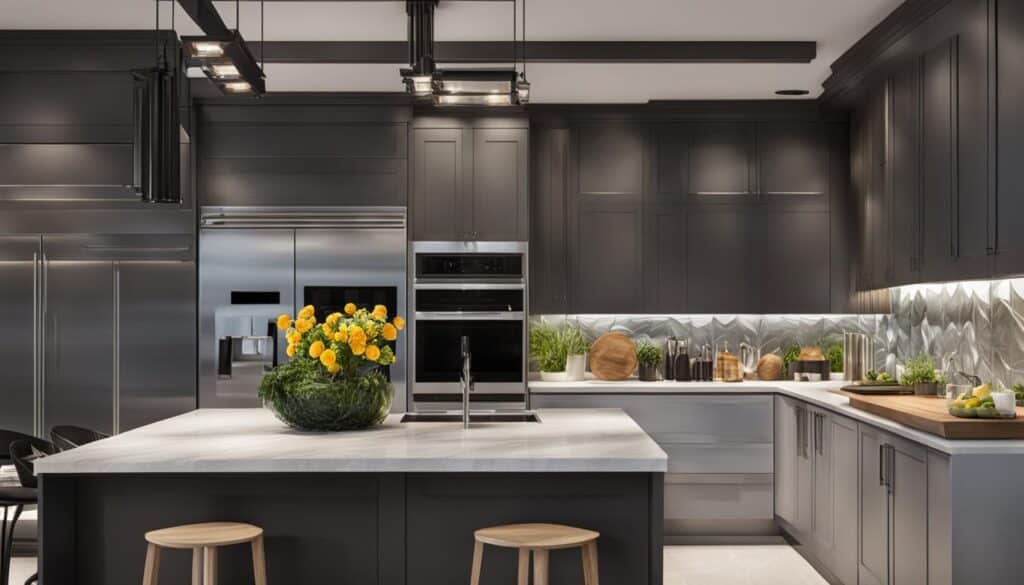
- Adhesive cable clips: These tiny clips can be stuck to the underside of your cabinets, walls, or other surfaces, and allow you to route your wires neatly. They’re easy to install, affordable, and can be removed without damaging surfaces. Make sure to choose a style that matches your kitchen aesthetics.
- Cable sleeves: If you have multiple wires running in the same direction, cable sleeves can keep them organized and protected. These sleeves are made from flexible materials and come in a variety of colors and styles to blend with your kitchen’s design.
- Cable raceways: For a more durable solution, consider using cable raceways, which enclose your wires in a sturdy channel. These can be mounted to the underside of your cabinets or the wall and can be painted to match your kitchen’s color scheme.
- Wire molding: This type of cable management solution offers a seamless look by hiding your wires beneath decorative molding. Depending on the style you choose, wire molding can either blend in with your cabinets or stand out as a design element.
When selecting a cable management system, it’s essential to consider the flexibility and accessibility of the solution. For example, if you plan on changing your under cabinet lights in the future or require easy access to the wires, opt for a system that allows for quick adjustments.
Remember, the key to successful cable management is to choose a solution that fits your kitchen’s design while ensuring safety and functionality.
To further help you choose the right cable management solution, let’s take a look at a table comparing their main features:
| Cable Management Solution | Pros | Cons |
|---|---|---|
| Adhesive cable clips | Easy to install, affordable, removable without damaging surfaces | May not hold heavier cables, adhesive may weaken over time |
| Cable sleeves | Keeps multiple wires organized, variety of colors and styles | May not blend seamlessly with all kitchens, some sleeves are difficult to adjust |
| Cable raceways | Durable, can be painted, offers a clean look | May require professional installation, can be more expensive than other options |
| Wire molding | Hides wires beneath decorative molding, can be a design element | Can be costly, may not be suitable for all kitchen styles |
In conclusion, choosing the right cable management solution requires careful consideration of your kitchen’s design and functional needs and your future plans for under cabinet lighting. By following the wire management tips provided here, you will be well on your way to selecting the perfect solution for your kitchen.
Ensuring Electrical Safety in Under Cabinet Lighting Installations
Electrical safety should never be overlooked when planning and executing under cabinet lighting installations. Taking the necessary precautions, such as turning off the circuit before beginning work, will ensure the safety of both you and your kitchen. This section provides essential tips and guidelines for maintaining electrical safety during under cabinet lighting installations.
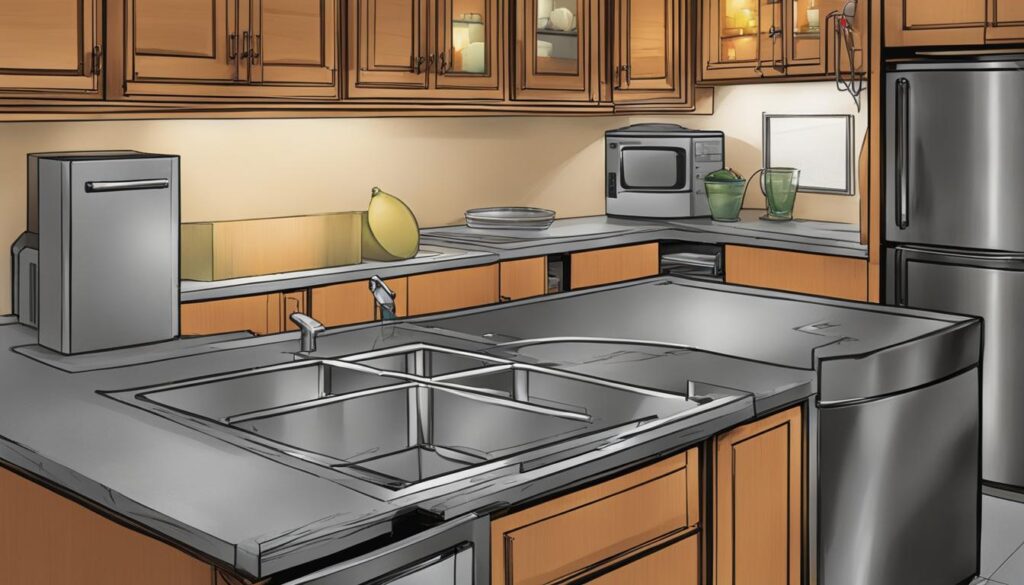
First and foremost, familiarize yourself with the dos and don’ts of electrical safety. This includes practices like never using wet hands when handling electrical components, avoiding the use of broken or damaged equipment, and keeping your work area dry and free of clutter. Remember that safety always takes top priority.
Always consult with a licensed electrician or follow the manufacturer’s instructions to ensure that your under cabinet lighting is installed safely and up to code.
When working on an electrical project, especially in an area prone to moisture, such as the kitchen, it’s wise to consider installing ground fault circuit interrupter (GFCI) outlets for added protection against electrical accidents.
Be mindful of the wire management system and follow the appropriate guidelines for installation. This not only ensures a clean and organized look but significantly reduces the risk of electrical hazards. Additionally, keeping physical barriers and isolators in place will protect against accidental contact with live wires during under cabinet lighting installations.
- Turn off the circuit that you’ll be working with
- Test the circuit with a voltage tester to confirm it’s off
- Use insulated tools and wear appropriate protective gear
Properly securing and enclosing electrical connections is also crucial to maintaining electrical safety. Loose wires can pose a serious risk, so be sure to use the appropriate connectors for your under cabinet lighting system and adhere to the manufacturer’s guidelines.
Lastly, remember that regular maintenance is a critical component of electrical safety. Regularly check your under cabinet lighting system for frayed wires, loose connections, or any other signs of wear, as these could be the sources of potential problems down the line.
In conclusion, never underestimate the importance of electrical safety when installing under cabinet lighting. By adhering to the necessary precautions, following guidelines, and staying vigilant, you’ll help to ensure that both you and your kitchen remain safe while enjoying the benefits of your new wireless under cabinet lighting system.
Installation Tips: Connecting and Organizing Wires Effectively
Organizing wires effectively and connecting them properly is critical for a successful under cabinet lighting project. Following step-by-step installation guidelines, using the right tools, and understanding the types of light bulbs can help achieve optimal results. In this section, I’ll share some important installation tips for connecting and organizing wires to ensure a seamless under cabinet lighting setup.
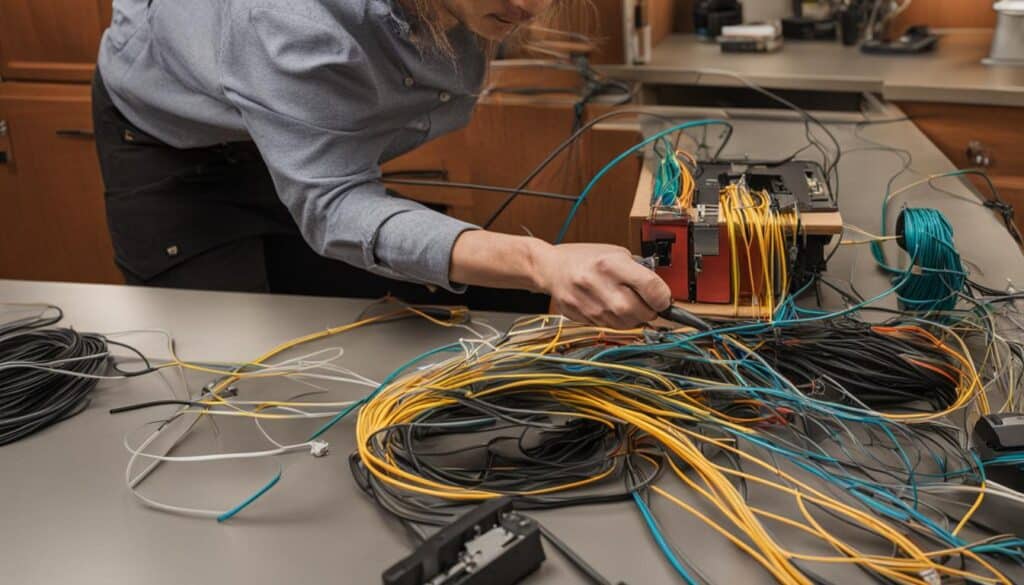
Before diving into the installation tips, keep in mind: always consult the manufacturer’s instructions specific to the under cabinet lighting system you have chosen and, if necessary, hire a professional electrician to guide you through the installation process.
Step-by-Step Guidelines for Organizing Wires
- Determine the best path for running wires from the power source to your under cabinet lighting system.
- Group wires together using wire clips, zip ties, or velcro straps to keep them tidy and avoid tangles.
- Carefully install wire channels, coverboards, or cable raceways along the path, hiding cables from sight and providing added protection.
- Secure the wires within these channels, neatly tucking them away while avoiding sharp bends or pinching.
- Label wires, if necessary, for ease of identification during installation and future maintenance.
Connecting Wires Properly
When it comes to connecting wires, it’s essential to be mindful of safety precautions and follow the appropriate techniques to create secure connections. Here are some tips:
- Always ensure the power is off before attempting to connect any wires.
- Use appropriate wire connectors, such as wire nuts or terminal blocks, to create strong connections that prevent wire slipping or short-circuits.
- Wrap the wire connections with electrical tape for added security and insulation.
- Test the connections before reassembling cabinets or fixtures to ensure proper functioning of the lighting system.
In addition to these tips, consider the types of light bulbs you’ll be using in your under cabinet lighting system. Different bulbs, such as LED, halogen, or incandescent, may require specific installation procedures and precautions. Always follow the manufacturer’s guidelines to ensure a safe and successful installation.
| Type of Light Bulb | Pros | Cons |
|---|---|---|
| LED | Energy-efficient, long-lasting, minimal heat output | Typically more expensive upfront |
| Halogen | Bright, crisp light, dimmable | Higher heat output, shorter lifespan than LED |
| Incandescent | Inexpensive, warm light output | Shorter lifespan, less energy-efficient than LED |
Following these installation tips and guidelines for connecting and organizing wires will help you create a safe, effective, and visually pleasing under cabinet lighting setup in your kitchen.
Conclusion
In conclusion, concealing wires for under cabinet lighting might seem like a daunting task, but with the right tools and techniques, you can transform your kitchen into a well-lit and stylish area. Considering the types of lights, the finish of your countertops, and the cable management system are crucial factors in achieving a seamlessly organized kitchen space.
By following the comprehensive under cabinet lighting guide I’ve provided, you can make informed decisions about which lighting styles, wire hiding methods, and cable management solutions best complement your kitchen’s design and function. Additionally, electrical safety should always be a top priority, whether you choose a DIY approach or enlist the help of a professional electrician.
As you embark on your kitchen lighting transformation, remember that a well-lit and clutter-free space not only enhances the aesthetics of your kitchen but also improves its functionality and efficiency. Happy illuminating!
FAQ
What are the benefits of under cabinet lighting?
Under cabinet lighting provides both functional task lighting and aesthetic appeal. It enhances the efficiency of your kitchen workspace and complements various kitchen styles.
How can I hide wires for my under cabinet lighting?
There are several techniques for hiding wires, such as using valances, recessed bottoms, or coverboards. You can also create a custom T-Square drill guide to keep wires neatly hidden under the cabinet bottom.
What are the differences between strip lights and puck lights for under cabinet lighting?
Strip lights provide even lighting distribution, while puck lights create focal lighting. Depending on your choice, the method of wire hiding and overall look may differ.
Can I add under cabinet lighting to an existing kitchen?
Yes, it is possible to add under cabinet lighting to an existing kitchen. Battery-powered puck lights are easy to install without electrical wiring, while other options may require more complex electrical work.
What is the cost of under cabinet lighting and its installation?
The cost of under cabinet lighting systems varies, ranging from $20 to over $160 per light, depending on the quality and type of lights. Professional installation by an electrician can cost between $70 and $120 per hour.
How do I choose the right cable management solution for my under cabinet lighting?
It’s essential to find a cable management system that fits both your aesthetic preferences and your kitchen’s functional needs. Numerous options are available, so consider the style and layout of your kitchen before making a decision.
What are some tips for ensuring electrical safety during under cabinet lighting installation?
Make sure to follow proper safety protocols, such as turning off the circuit before starting work. Hiring a professional electrician helps ensure that your lighting is installed safely and up to electrical code standards.
How do I connect and organize wires effectively for under cabinet lighting?
Follow step-by-step installation guidelines, use the appropriate tools, and understand the types of light bulbs to achieve optimal results. Proper wire organization and connection are crucial for a successful under cabinet lighting project.

